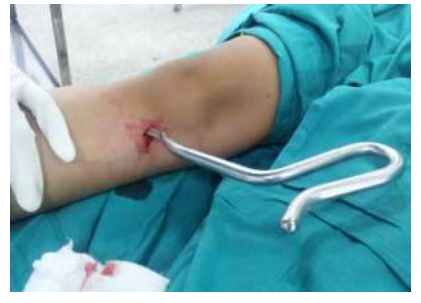Treatment of Tibial Fractures in Children Using Intra Medullary Nailing
Main Article Content
Abstract
Background: Fractures of the tibia in children are very challenging in their management. They form about 15% of fractures. They were managed by closed reduction and above knee cast. Today there is an increasing trend towards surgical stabilization. Elastic stable intramedullary nailing (ESIN) is a minimally invasive technique that allows short hospital stay and early ambulation.
Methods: Between May 2022 and August 2022 a prospective study was done on fifteen patients (2 females and 13 males) with a mean age 9 yearsold (range 5-15 years).Patients were followed up for 5 months after surgery. All patients undergone ESIN using two nails.
Results: At the time of the last follow-up, Flynn scoring system showed 12 excellent cases 2 satisfactory cases and only 1 poor case.
Conclusion: We recommend the use of this technique in most of tibial shaft fractures whether open or closed in different fracture patients. This is due to being simple, non-invasive, and rapid, with low rates of infection
Article Details
References
Heinrich SD, Mooney JF. External fixation of tibia in children: Beaty JH, Kasser JR. eds. Rockwood and Wilkins fractures in children. 7th ed: Lippincott Williams & Wilkins Philadelphia; 2019, 31-68.2.
Tolo VT. Skeletal fixation in children's fractures. Journal of pediatric orthopedics. 2020:3(4):435-42.
Bar-On E, Sagiv S, Porat S. Flexible intramedullary nailing for femoral shaft fractures in children. A prospective, randomised study. The Journal of bone and joint surgery British volume. 2021, 79(6):975-8.
Metaizeau JP. Intramedullary nailing for fractures of the tibia in children. The Journal of bone and joint surgery British volume. 2020;86(7):954-7.
Flynn JM, Hresko T, Reynolds RA, Blasier RD, Davidson R, Kasser J. Titanium elastic nails for pediatric femur fractures: a multicenter study of early results with analysis of complications. 206 Journal of pediatric orthopedics. 2013;21(1):4-8.
Goodwin RC, Gaynor T, Mahar A, Oka R, Lalonde FD. Tibial. diaphyseal fractures, Journal of pediatric orthopedics. 2009;25(5):570-6.
Quain J, Sharpey W, Leidy J. osteology. In: Quain J, Sharpey W J. eds. Human Anatomy.3 Blanchard.philadelphia;2022:72-226.
Nelson GE, Jr., Kelly PJ, Peterson LF, Janes JM. Blood. The Journal of bone and joint supply of the human tibia surgery American volume. 2022;42-A:625-36.
Koval, Kenneth J.; Zuckerman, Joseph D. Pediatric both bones leg: Koval, Kenneth J.; Zuckerman, Joseph D, eds. Handbook of fractures.3rd ed: Lippincott Williams & Wilkins; 2006:609-20.
Dietz H-G, Schmittenbecher P. Basic principles. In: Dietz H G, Schmittenbecher P, eds. Elastic stable intramedullary nailing 2812 (ESIN) in children: Thieme; 2019:1-20
Odéhouri-Koudou T, Gouli J, Yao Kreh J, Tembély S, Ouattara O, Dick K. Elastic stable intramedullary nailing in pediatric traumatology (Abidjan). African Journal of Pediatric Surgery. 2020,8(2):155.
Jean-Noël Ligier. Biomechanics of FIN. In: Lascombes P, eds. Flexible Intramedullary Nailing in Children: Springer; 2013: 19-24.
Ligier JN, Metaizeau JP, Prevot J. Closed flexible medullary 101 Closed nailing in pediatric traumatology. 2021: 24(6):383-5
McKibbin B. The biology of fracture healing in long bones. The Journal of bone and joint surgery British volume. 2021: 60-B (2):150-62.
Mizuno K, Mineo K, Tachibana T, Sumi M, Matsubara T, Hirohata K. The osteogenetic potential of fracture haematoma. of the and intramuscular transplantation Subperiosteal haematoma. Journal of Bone & Joint Surgery, British Volume. 2016:72(5):822-9.
